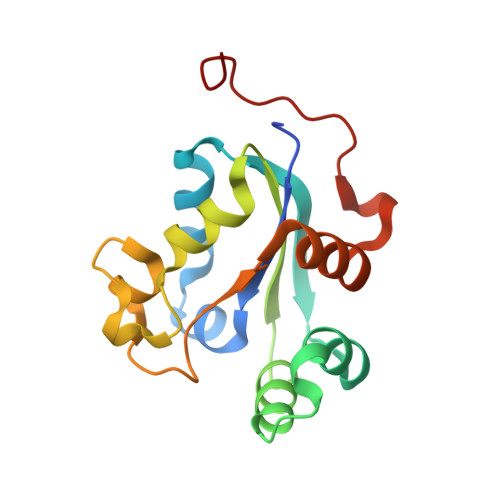Chemical rescue of phosphoryl transfer in a cavity mutant: a cautionary tale for site-directed mutagenesis.
Admiraal, S.J., Meyer, P., Schneider, B., Deville-Bonne, D., Janin, J., Herschlag, D.(2001) Biochemistry 40: 403-413
- PubMed: 11148034
- DOI: https://doi.org/10.1021/bi002472w
- Primary Citation of Related Structures:
1HLW - PubMed Abstract:
We have explored the ability of a nucleoside diphosphate kinase (NDPK) mutant in which the nucleophilic histidine has been replaced by glycine (H122G) to transfer phosphate from ATP to alcohols of varying pK(a), size, shape, and polarity. This cavity mutant does indeed act as a primitive alcohol kinase. The rate of its phosphoryl transfer to alcohols varies considerably, with values spanning a DeltaDeltaG(double dagger) range of 4 kcal/mol, whereas the alcohols have very similar intrinsic reactivities. Analysis of these results suggests that the ability to carry out phosphoryl transfer within the cavity is not a simple function of being small enough to enter the cavity, but rather is a complex function of steric, solvation, entropic, van der Waals packing, and electrostatic properties of the alcohol. In addition, large differences are observed between the reactivities of alcohols within the nucleophile cavity of H122G and the reactivities of the same alcohols within the nucleophile cavity of H122A, a mutant NDPK that differs from H122G by a single methyl group within the cavity. The crystal structures of the two cavity mutants are very similar to one another and to wild-type NDPK, providing no evidence for a structurally perturbed active site. The differences in reactivity between the two mutant proteins illustrate a fundamental limitation of energetic analysis from site-directed mutagenesis: although removal of a side chain is generally considered to be a conservative change, the energetic effects of any given mutation are inextricably linked to the molecular properties of the created cavity and the surrounding protein environment.
Organizational Affiliation:
Department of Biochemistry, Beckman Center B400, Stanford University, Stanford, California 94305-5307, USA.














